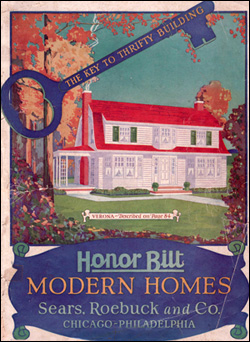Sears, Roebuck and Company
 From
about 1908 to 1940, Sears Roebuck plied the materials and kit home market
with its home plans and several lines of ready-to-build kits. They offered
a line called Simplex Sectional Portable Buildings that were prefabricated
sections ("Quickly Bolted Together ... No Sawing — No Nailing")
that at least theoretically could be assembled, disassembled, and moved.
The Honor Bilt "Already Cut and Fitted" was their more upscale
offering, with Standard Bilt as a lower-end option.
From
about 1908 to 1940, Sears Roebuck plied the materials and kit home market
with its home plans and several lines of ready-to-build kits. They offered
a line called Simplex Sectional Portable Buildings that were prefabricated
sections ("Quickly Bolted Together ... No Sawing — No Nailing")
that at least theoretically could be assembled, disassembled, and moved.
The Honor Bilt "Already Cut and Fitted" was their more upscale
offering, with Standard Bilt as a lower-end option.
Homes in a box, delivered to the local train depot from regional manufacturers, allowed many a frugal home buyer to get a good quality house for a reasonable price. The styles ranged from the Craftsman-style bungalow of the 1910s and 20s to the English Cottage and Spanish Revival as well as the ever popular Colonial Revival and its subtypes.
Today, the Sears home is synonymous with kit house. Many people haven't any idea what Gordon Van Tine or Aladdin offered, but almost everyone who has a passing interest in old houses has heard of the "Sears kit home."
As might be expected, there is a hope among many old house owners that theirs could be a Sears kit. According to the information on Aladdin kit houses, it's estimated that between 1908 and 1981, there were 70,000 Aladdin homes manufactured. Sears, in the kit house business for just over 30 years, sold 70-75,000 according to the Sears Archives. The total number of kit homes sold will likely never be known as so many of these houses, originally built in close-in "suburban" neighborhoods in their day, have been torn down and replaced as cities and towns expanded.
Do you have a Sears kit home?
One way to identify your house as a kit home starts with locating likely plans from various kit home companies and comparing various features. Once a possibility surfaces, the second step is taking measurements and comparing them with the kit home dimensions. A kit house should be "spot on" ... however, even if it isn't, don't throw in the towel right away. Though the exterior dimensions didn't change, some plans went through different iterations with changes to the floor plan from one catalog to the next.
Make sure you thoroughly research the model, if possible. For example, take the Sears Glendale. You measure your house and the dimensions are 22'x30'6" ... the same as shown in the 1923 catalog. You might conclude though, that what you hope is a Glendale, isn't because the plan is different and the room dimensions don't match. However, as long as the exterior dimensions synch up, with a bit more research, you may discover that your home is the earlier version of the Glendale, Modern Home No. 264P148, which was offered in the 1916 catalog with a substantially different floor plan.
Corroborating your hunch means checking beams in the basement and attic for tell-tale marks and stamps that might indicate the manufacturer. Each company had a different way of marking their parts.
Also, it should be noted that many of the kit home manufacturers sold plans and materials, so while not a "kit house" per se, you could still have a Sears or Wards plan built with their materials, or their plan built with local materials.
Or you might have a unique kit home. Many manufacturers, including Sears, took plans submitted by customers and manufactured custom homes.
Because everyone stole ideas from each other, it's sometimes difficult to determine the origin of an old house. In that case, you research as far as you can and then sit back and enjoy the house you have.
© 2008–2016 — Antique Home Style
Books, ETC.
